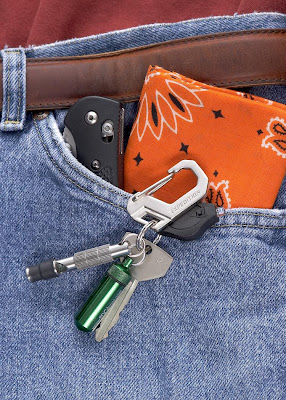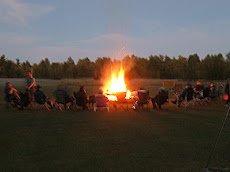Here's a couple possible solutions to that problem that I highly recommend:
Solution 1. Doug Ritter / Adventure Medical Kits Pocket Survival Pack (modified)
 Doug's PSP is a very well thought out compilation of basic survival components that comes prepackaged in a highly water resistant, translucent zip pouch. Here's the contents list as provided by Doug and AMK:
Doug's PSP is a very well thought out compilation of basic survival components that comes prepackaged in a highly water resistant, translucent zip pouch. Here's the contents list as provided by Doug and AMK: - Spark-Lite™ Firestarter
- 4 Spark-Lite™ Tinder-Quik™
- Fox-40® Rescue Howler™ Survival Whistle
- Rescue Flash™ Signal Mirror, 2 x 3 inches 20mm
- Survival Compass
- Duct Tape - 26 inches x 2 inches
- Stainless Steel Utility Wire - 6 ft.
- Braided Nylon Cord - 10 ft. 150+ lb.
- #69 Black Nylon Thread - 50 ft.
- Fishing Kit - 4 x medium Fish Hooks, 2 x Split Shot and 1 x Snap Swivel, in a clear plastic vial with cap.
- Heavy Duty Sewing Needle
- 4 Safety Pins
- Heavy Duty Aluminum Foil - 3 sq. ft.
- #2 Pencil and Waterproof Notepaper - 2 pieces
- #22 Scalpel Blade *REMOVE TO CLEAR SECURITY CHECKPOINTS*
- Kit Specific Illustrated Survival Instructions
- Contents List
- Fresnel Lens Magnifier - 2 x 3 inches
- Pocketsize Clear Vinyl Pouch - 4 x 5 inches
- Weight: 3.9 oz
The PSP is a great value. Purchase of the PSP is cheaper than buying the individual components and all of the components are top shelf items. IE. See my whistle and signal mirror test results on this site as proof positive of the quality of this kit's components.
Although a great value, the PSP can be made better. A little forethought by the purchaser in making some appropriate additions can save a lot of grief in an emergency. Here's some suggestions for possible additions:
- Add in a Reynolds oven bag, Gerber baby milk bag or USGI hot water bag for water storage.
- Add in a few MicroPur water purification tablets or other individually wrapped water purification tabs of your choice or preference.
- Add in a few bandaids and simple wound management stores.
- Add in a Photon LED flashlight of your choice.
- Add in a day or two worth of personal medication.
Another suggestion is to make up and include an identification card that includes In Case of Emergency (I.C.E.) information for rescuers should you be injured or otherwise unresponsive.
An I.C.E. card should include your name, address, emergency contact info, medical info, and allergy info, and any other info you might have that would aid rescuers in treating your condition(s).
With the aforementioned additions; the PSP becomes a complete means of providing meaningful, field tested and proven gear to assist you in meeting basic survival requirements of water, shelter, fire, first aid, food procurement, signaling and self rescue.
Solution 2. Home Rolled Pocket Survival Kit (PSK)
Only you know your personal skill level and what you really need to bring with you to improve your fare in an emergency. Find a small easily pocketable container like the Witz ID Locker shown above and assemble your own PSK. As stated above, make certain that you have a sufficient store of gear to meet survival basics - include items for:
- Water storage and purification,
- Shelter and/or shelter building,
- Firemaking,
- First aid,
- Food procurement,
- Signaling and self rescue.
You may also want to include utility items like a small pocket pack of duct tape, sewing needle and a floss card, among others, to assist in field expedient means of gear maintenance and repair. Lastly, throw in an I.C.E. card as discussed above.
The PSK shown above is my personal "I can't take a blade" kit. It includes:
- Witz ID Locker transparent, crush and water resistant case
- A section of ranger band (rubber band made from an inner tube to be used for tinder)
- Two preassembled 12' fishing lines
- USGI MRE Hot Water Bag with markings for up to 16 ounces of water
- MicroPur Water Purification tabs
- SparkLight
- TinderQuik
- Light-My-Fire mini FireSteel and striker
- AMK mini signal mirror
- Acme Tornado whistle
- Button compass
- Floss card w/ sewing needles and threader taped on
- Bobbin of #69 black sewing thread
- ICE Card
I carry the kit shown above with a separate, dedicated First Aid Kit which is also geared up for my specific needs. This First Aid Kit is assembled in a very small Witz See-It-Safe. I've separated the kits in an attempt at minimizing the possibility of being separated from all of my emergency stores by the loss of one single package.
These two mini kits, along with my normal EDC items on my keyring and pockets, give me a lot of emergency support in several easy to carry, unobtrusive packages...
M




















